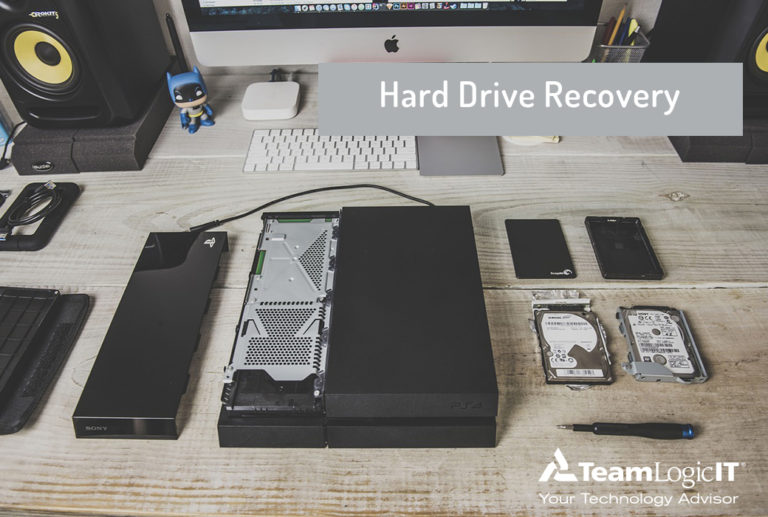Dallas Data Recovery
We store a lot of important information on our computers and devices; documents, photos and videos. Unfortunately, technology can and will fail us at some point in time. Therefore, it is critical to regularly implement backup and recovery strategies to protect our data from hard drive problems.
Hard drive recovery is the process of recovering data and restoring a hard drive to its last known good configuration, after a system or hard drive crashes or is corrupted and damaged.
WHAT ARE TWO TYPES OF HARD DRIVE PROBLEMS?
There are two types of hard drive problems: mechanical (physical) and logical. If your hard drive is not working it’s more likely a mechanical problem. With a mechanical crash, some physical part of the hard drive breaks. A hard drive is made up of a spinning metal platter, on which all of the data is stored. When there is a physical error, your data usually remains intact on the metal platter, but the spinning mechanism or the head that reads the data off the platter might break.
There are a number of reasons for hard drive mechanical crashes:
Some form of collision where a laptop is dropped, bumped into or hit, or used carelessly
Extremely high temperatures or poor ventilation systems on hardware may cause insufficient cooling and result in damage to the internal hard disk
Water damage from flooding, spilt liquids or moisture seeping into the hard disk case
Power supply issues from lightning strikes, power failures or damaged power lines
In addition, the following symptoms will help you to recognize physical damage: the computer’s operating system cannot recognize the hard disk and there may be a continuous noise emerging from the inside of the computer which may sound like buzzing, grinding, clicking or a crashing sound from the damaged disk.
If these symptoms are existing in your hard drive and it is not detected by your computer anymore, then you are dealing with physical damage to the hard drive and you have no choice but to take it to an IT support company that will have to open the hard drive and replace the broken piece, so that it can spin again and the data can be read. This is a tedious and delicate process, and it can be expensive. However, if you need emergency disaster recovery to save important data, then this may be your only option.
A logical hard drive crash occurs when your computer can’t read the files off of your hard drive. The hard drive may still function normally (none of the hardware is broken), it’s just that the data can’t be read. The primary causes of logical failure are:
Virus attack or damage to the hard disk by Malware and software bugs
Firmware corruption
Human errors which may include accidentally deleting files necessary for the disk to function, corrupted files due to accidentally and unexpectedly shutting down a computer, improperly closing programs, or installing infected software, formatting partition, clicking on corrupted sites/links, or tampering with files essential to the hard disk.
With a logical hard drive failure, you may see the infamous blue screen, and you may also notice that the computer’s performance has drastically decreased or some of the data has disappeared.
WHAT ARE SOME WAYS TO PREVENT HARD DRIVE FAILURES?
Determined by the reason, there are times when it is not possible to prevent hard drive failures, but many of the ordinary types of hard drive failures can be prevented by doing these common-sense actions:
Having a computer assessment, system assessment, and network assessment will ensure all vital signs are good, systems are functioning properly, and your network is secure against the latest threats.
Installing malware and virus scanners to protect computers and prevent it from downloading files or programs that can be detrimental to the hard drive
Performing regular backups
Routine maintenance and scans on computers to make sure that all the disks are running correctly and storage files are defragmented. While these maintenance scans may not prevent a hard drive failure, they can safeguard against irreparable damage by bringing system errors to light.
Computers and the surrounding areas should be routinely cleaned. The case surrounding a hard disk is never completely impenetrable, and if a small speck of dust enters the casing and obstructs the read-write head, it can cause a head crash
Proper ventilation and cooling of the computer is one of the best ways to protect the hard drive. Any fans or ventilation grids on the computer should not be blocked, and if there is any excessive overheating, then the computer should be turned off and allowed to cool down. If the excessive overheating persists, then the computer should be taken in and serviced by an experienced IT company.
To prevent dangerous power surges from damaging the hard disk, one should unplug the computer when it is not in use. If the computer tends to be used frequently and throughout the day, and unplugging it after each use is inconvenient, then it is preferable to use a surge protector when keeping the computer plugged in.
Any data loss is unique in terms of severity, nature, and circumstances. That is why it always requires a unique course of action. When choosing a computer support company or a Managed Services provider, be sure they are able to perform disaster recovery from any brand, any model, and any operating system. Because there are so many types of data loss some IT consulting companies may not know how to deal with your situation.
If you need hard drive data recovery Dallas, or in Plano, Richardson and surrounding areas, let our expert technicians from TeamLogicIT Plano do it for you. Give us a call at (469) 573-3743 or go to our website teamlogicitplanotx.com.
WHAT ARE FREQUENTLY ASKED QUESTIONS ABOUT HARD DRIVE DATA RECOVERY
HOW LONG DOES AN AVERAGE HARD DRIVE LAST?
The average hard disk lasts somewhere between 3 and 5 years before it will fail and need to be replaced.
WHAT ARE THE ODDS THAT A HARD DRIVE WILL CRASH?
It appears that hard drives have three distinct failure “phases.” In the first phase, which lasts 1.5 years, hard drives have an annual failure rate of 5.1%. For the next 1.5 years, the annual failure rate drops to 1.4%. After three years, the failure rate explodes to 11.8% per year.





